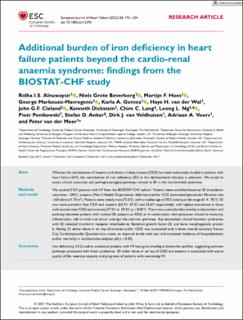Additional burden of iron deficiency in heart failure patients beyond the cardio-renal anaemia syndrome: findings from the BIOSTAT-CHF study
| dc.contributor.author | Alnuwaysir, Ridha I.S. | |
| dc.contributor.author | Grote Beverborg, Niels | |
| dc.contributor.author | Hoes, Martijn F. | |
| dc.contributor.author | Markousis-Mavrogenis, George | |
| dc.contributor.author | Gomez, Karla A. | |
| dc.contributor.author | van der Wal, Haye H. | |
| dc.contributor.author | Cleland, John G. | |
| dc.contributor.author | Dickstein, Kenneth | |
| dc.contributor.author | Lang, Chim C. | |
| dc.contributor.author | Ng, Leong L. | |
| dc.contributor.author | Ponikowski, Piotr | |
| dc.contributor.author | Anker, Stefan D. | |
| dc.contributor.author | van Veldhuisen, Dirk J. | |
| dc.contributor.author | Voors, Adriaan A. | |
| dc.contributor.author | van der Meer, Peter | |
| dc.date.accessioned | 2022-04-19T13:03:13Z | |
| dc.date.available | 2022-04-19T13:03:13Z | |
| dc.date.created | 2022-02-04T14:35:34Z | |
| dc.date.issued | 2022 | |
| dc.identifier.issn | 1388-9842 | |
| dc.identifier.uri | https://hdl.handle.net/11250/2991353 | |
| dc.description.abstract | Aims Whereas the combination of anaemia and chronic kidney disease (CKD) has been extensively studied in patients with heart failure (HF), the contribution of iron deficiency (ID) to this dysfunctional interplay is unknown. We aimed to assess clinical associates and pathophysiological pathways related to ID in this multimorbid syndrome. Methods and results We studied 2151 patients with HF from the BIOSTAT-CHF cohort. Patients were stratified based on ID (transferrin saturation <20%), anaemia (World Health Organization definition) and/or CKD (estimated glomerular filtration rate <60 ml/min/1.73 m2). Patients were mainly men (73.3%), with a median age of 70.5 (interquartile range 61.4–78.1). ID was more prevalent than CKD and anaemia (63.3%, 47.2% and 35.6% respectively), with highest prevalence in those with concomitant CKD and anaemia (77.5% vs. 59.3%; p < 0.001). There was a considerable overlap in biomarkers and pathways between patients with isolated ID, anaemia or CKD, or in combination, with processes related to immunity, inflammation, cell survival and cancer amongst the common pathways. Key biomarkers shared between syndromes with ID included transferrin receptor, interleukin-6, fibroblast growth factor-23, and bone morphogenetic protein 6. Having ID, either alone or on top of anaemia and/or CKD, was associated with a lower overall summary Kansas City Cardiomyopathy Questionnaire score, an impaired 6-min walk test and increased incidence of hospitalizations and/or mortality in multivariable analyses (all p < 0.05). Conclusion Iron deficiency, CKD and/or anaemia in patients with HF have great overlap in biomarker profiles, suggesting common pathways associated with these syndromes. ID either alone or on top of CKD and anaemia is associated with worse quality of life, exercise capacity and prognosis of patients with worsening HF. | en_US |
| dc.language.iso | eng | en_US |
| dc.publisher | Wiley | en_US |
| dc.rights | Navngivelse-Ikkekommersiell 4.0 Internasjonal | * |
| dc.rights.uri | http://creativecommons.org/licenses/by-nc/4.0/deed.no | * |
| dc.title | Additional burden of iron deficiency in heart failure patients beyond the cardio-renal anaemia syndrome: findings from the BIOSTAT-CHF study | en_US |
| dc.type | Journal article | en_US |
| dc.type | Peer reviewed | en_US |
| dc.description.version | publishedVersion | en_US |
| dc.rights.holder | Copyright 2021 The Author(s) | en_US |
| cristin.ispublished | true | |
| cristin.fulltext | original | |
| cristin.qualitycode | 2 | |
| dc.identifier.doi | 10.1002/ejhf.2393 | |
| dc.identifier.cristin | 1997913 | |
| dc.source.journal | European Journal of Heart Failure | en_US |
| dc.source.pagenumber | 192-204 | en_US |
| dc.identifier.citation | European Journal of Heart Failure. 2022, 24(1), 192-204. | en_US |
| dc.source.volume | 24 | en_US |
| dc.source.issue | 1 | en_US |
Tilhørende fil(er)
Denne innførselen finnes i følgende samling(er)
-
Department of Clinical Science [2294]
-
Registrations from Cristin [9489]

